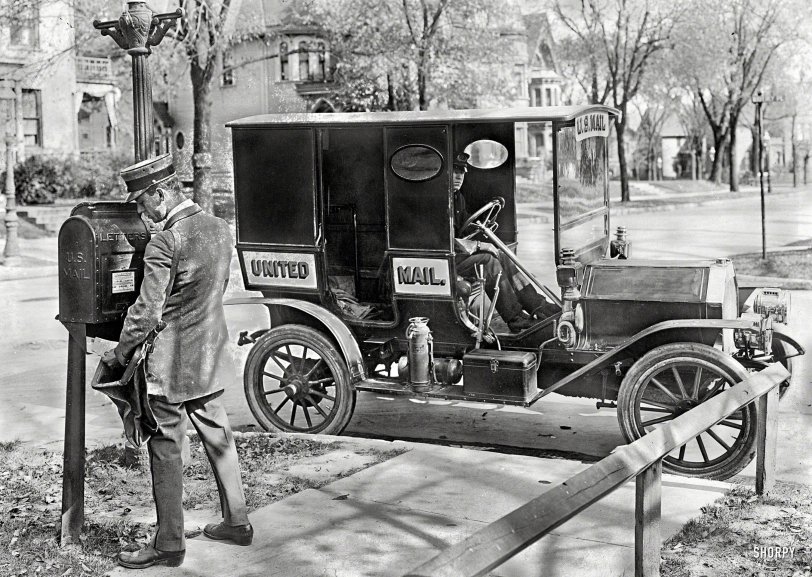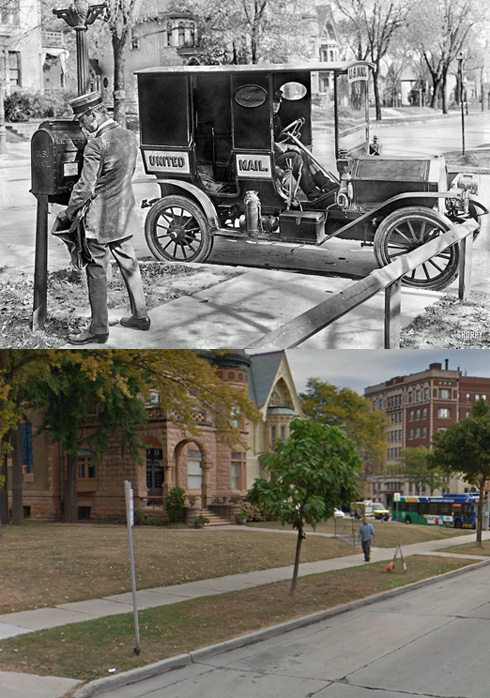


Framed or unframed, desk size to sofa size, printed by us in Arizona and Alabama since 2007. Explore now.
Shorpy is funded by you. Patreon contributors get an ad-free experience.
Learn more.

- What a headache!
- Baldwin 62303
- Baldwin VO-1000
- Cold
- No expense spared
- Tough Guys
- Lost in Toyland
- And without gloves
- If I were a blindfolded time traveler
- Smoke Consumer Also Cooks
- Oh that stove!
- Possibly still there?
- What?!?
- $100 Reward
- Freeze Frame
- Texas Flyer wanted
- Just a Year Too Soon
- WWII -- Replacing men with women at the railroad crossing.
- Yes, Icing
- You kids drive me nuts!
- NOT An Easy Job
- I wonder
- Just add window boxes
- Icing Platform?
- Indiana Harbor Belt abides
- Freezing haze
- Corrections (for those who care)
- C&NW at Nelson
- Fallen Flags
- A dangerous job made worse
Print Emporium
The Lettermen: 1915

Circa 1915. "Mailman and truck," location unknown. Collection times 6:15 a.m. to noon. National Photo Company Collection glass negative. View full size.
Location Found!
Just came across this image. I thought the street sign said Waverly Pl, which is on the lower east side of Milwaukee. Drove around street view until I came across the intersection of Waverly Pl and Juneau Ave. This is looking east down Juneau. The peaked roof building in the background is the key. This neighborhood still has a number of beautiful mansion-quality homes, but so many have fallen to the wrecking ball in favor of parking lots and faceless apartment buildings. Oh, to travel time.

Noon? Or later?
Even though it does look like "12:00 P.M." in the photo, I wonder if it isn't a blurry 10:00 P.M. instead. A few things occur to me. One is that the Post Office used to collect mail typically throughout the day, with both morning and afternoon (and sometimes evening) collection times. Another is that the lower part of the placard is divided into two sections, which may be an early version of the two-column A.M./P.M. format that the Post Office used for many years. If so, what we're seeing are two morning times and two afternoon/evening times. Also, it's a fairly modern thing to refer to noon as "12:00 P.M." In 1915 they would have (correctly) said "12:00 Noon."
[The card says "12:00 P.M." - Dave]
So it does! And the two sections at the bottom of the placard are Sunday and holiday collection times. Thanks for the detail.
Thing is, if Sunday collections were at 8:20 A.M. and 9:45 P.M. and holiday collections were at 9:30 A.M. and 9:25 P.M., then "12:00 P.M." almost certainly means midnight. Probably a limitation of having "A.M." and "P.M." preprinted on the placard.

Milwaukee
This exact picture is shown in the book Motorized Mail by James H. Bruns and published by the Smithsonian Institution in 1997. The caption states the following on page 83 (paragraphing added).
"In 1911, the Post Office Department tested 'drop bottom' mailboxes in 20 cities, including Milwaukee, Wisconsin where this half-ton Johnson Service Co. 'light delivery wagon' was used for collections. The Milwaukee made vehicle was powered by a four-cylinder, 35-hp gasoline engine.
"The idea for drop bottom boxes came from David C. Owens, Milwaukee's postmaster. 'The idea appealed to me,' Owens said, 'when I first became postmaster and being formerly in the coal business, where drop bottom cars have become generally used, I thought the same principle could be applied to the mailbox. In this way, the carrier can empty a dozen or more boxes in the same time as he could empty one by the old method of reaching in and hauling the mail out by hand.'
"This type of box was basically the same as the others then in use, except that instead of removing mail from the front or side, these had a hinged bottom that would automatically dump all the contents into the carrier's sack as soon as it was unlocked. The first 500 drop bottom boxes were manufactured in Milwaukee by the A.O. Smith Co."
The Johnson Service Co. made a variety of steam and gas vehicles from 1901 to 1912. "Johnson" is Professor Warren S. Johnson (1847 - 1911) of the State Normal School, now the University of Wisconsin - Whitewater, who received a patent for the first electric room thermostat. His company, which began in 1885, survives today and is now known as Johnson Controls. Since 1978 the firm has again been involved with automobiles - first with making batteries and gradually adding the ability to make all of the interior parts of a vehicle.
You may have seen Johnson's handiwork when visiting Philadelphia. His pneumatic time system was installed in the Philadelphia City Hall Clock in 1898 (started Jan 1, 1899). The Floral Clock at the Louisiana Purchase Exposition (St. Louis World's Fair) of 1904 also used his invention (the clock works still exist).
Right-Hand Drive
"[All U.S. mail delivery vehicles are right-hand drive for that very reason. -tterrace]"
Not all. I had an ex-Postal Delivery Jeep (1968 Kaiser DJ-5) with a steering wheel on the left side. A limited number of them were made in this fashion for Postal Inspectors, mechanics and supervisors. Of course, the primary heat outlets were STILL on the right side for my non-existent passenger. But it was the best $750 I ever spent on a car.
However, you're right in that all Mail Delivery trucks had right-hand drive.
Why mailmen drive
The driving letter carrier (aka "mailman") is largely a post-WWII development. Prior to that, carriers mostly walked, except in rural areas. Vehicles were mostly used to transport mail between postal stations, deliver parcel post and carrier relay mail - segments of the carriers' load placed in special boxes (the ones marked "not for deposit of mail") to access as they progressed along the route. After the war, the growth of suburbia and the increasing volume of mail made this system increasingly impractical; having the carriers take all their own mail, including parcel post, was more efficient. The carriers you see walking today are using the park-and-loop method; rather than driving to each address, they'll park, take a satchel of several blocks' worth of mail and follow a circular path from the truck and back, then drive to the next point and repeat the process.
Right-hand drive: deliberate, or default?
Although Americans have driven on the right-hand side of the road since at least the 1790s, Henry Ford was the first person to persuasively argue the case for a driver sitting on the left, in 1908. Even in 1915, most vehicles (including this non-Ford) by default had the controls on the right, and the USPS (like many fleet owners) had not yet learned the wisdom of limiting the number of different makes and models in service.
But it seems that in 1954, Popular Mechanics felt their readers would find a right-hand drive mail truck (the Jeep many of us recall from our youth) a "Continental" novelty.
I was wondering why the USPS website had such a large gap in their collection of historical mail vehicles. Oh, of course. Depression budget cuts, followed by wartime rationing. It seems that in the interim, the Ford Model A was the postal truck of choice. Anybody in the DC area (hint, hint) care to walk or take the Metro to the National Postal Museum and tell me if this one is right-hand drive?
Motorized Postal Service
I fall in with tterrace and think this might have been a photo op showcasing the motorization of the postal force; it coincides with the retirement of the last postal horses in Washington.
The letterbox being emptied appears similar to the drop-bottom design patented by Dr. S. Clifford Cox of Washington, DC. More info at previous Shorpy post Letterbox: 1912.
The center of Bethesda, Maryland has a short Waverly Street but the area is so redeveloped that Google Maps doesn't yield any obvious matches.
Washington Post, June 6, 1915.Motors Only to Carry Mail
Last Horse Soon to Be Dropped From Service Here.
The horseless age is not a dream of the distant future. At least, it is not in so far as Uncle Sam's Washington mail service is concerned. Within the next 90 days, it develops from an announcement yesterday, the last “Old Dobbin” on the city postoffice force will be thrown into the discard and the service will be placed entirely on a motor basis.
Only sixteen horses have survived the rapid motorization of the service so far, and those are slated to go. The complete motorization of the service was brought measurably nearer last week when the horse-driven collection wagons in use of in the eastern section of the city were superseded by automobiles.
St. Louis?
Due to the victorian homes, I cross searched victorian homes with Waverly Place and came up with a bit of St. Louis history.
[The National Photo Company operated in just the Washington, D.C. area, though. -tterrace]
Playing post office
There's no telling what the purpose of this photo is, so it may not fully reflect real postal operations. One guess is that it was to illustrate the Post Office Department's use of motorized vehicles, and the idea was to make the shot more interesting by having a larger cast and more action, as it were. Normally there'd be no reason for postal employees to be traveling in pairs. Anyway, in actual practice, the only reason a carrier would service a collection box of that size would be to remove the outgoing mail, and any processing, including sorting, would be done back at the post office, not in the truck.
Sorting?
Wonder if the mailman has a driver in order that he can perform sorting or other similar tasks as he is being chauffeured about on his route. Scenically, I noted that the lampposts are equipped with the "arms" on which the "Old Lamplighter" would rest his ladder when tending the lamps.
Photo op does make more sense, tterrace. Semper vigilans!
Re: Right-Hand Drive
tterrace is correct about USPS delivery vehicles still being right-hand drive. However, in c.1915, many, if not most, US-built commercial trucks were right-hand drive, regardless of application. I don't know why trucks were often right-hand drive when passenger cars had already become uniformly left-hand drive in the U.S. It seems that by the end of WWI, American trucks had mostly become left-hand drive.
Right-hand-drive vehicle
The mailbox says US mail so we know it is the United States at least. Why then is it the truck right-hand-drive? Is it so the driver is closer to the edge of the road so he can put stuff in some letterboxes without leaving his seat?
[All U.S. mail delivery vehicles are right-hand drive for that very reason. -tterrace]
H-pattern gearshift
The lever closest to the driver is almost certainly for shifting gears. At its base is a gate mechanism with two arched parallel slots with a path between them at the halfway point. This to to enforce the H-pattern.
Re: Why two levers?
The other may be to disengage the transmission and/or to switch from forward to reverse.
Mail Period
There's that obligatory period again. Right after mail.
Not Entirely Unknown
Well we do know it's at the intersection of Waverly Place and some other road, surely some intrepid individual can put match it to a city.
Where is it today?
That delivery truck, so beautiful! As late as the 1970s, in Queens NY City, we had a cast iron mailbox like this mounted on a cement pole. When the lid flapped closed it did so with a dull THUD.
Why two levers?
I was surprised to see the mailman has a driver. What are the two levers for by his right knee. One looks like a parking brake. What's the other one for?
























On Shorpy:
Today’s Top 5